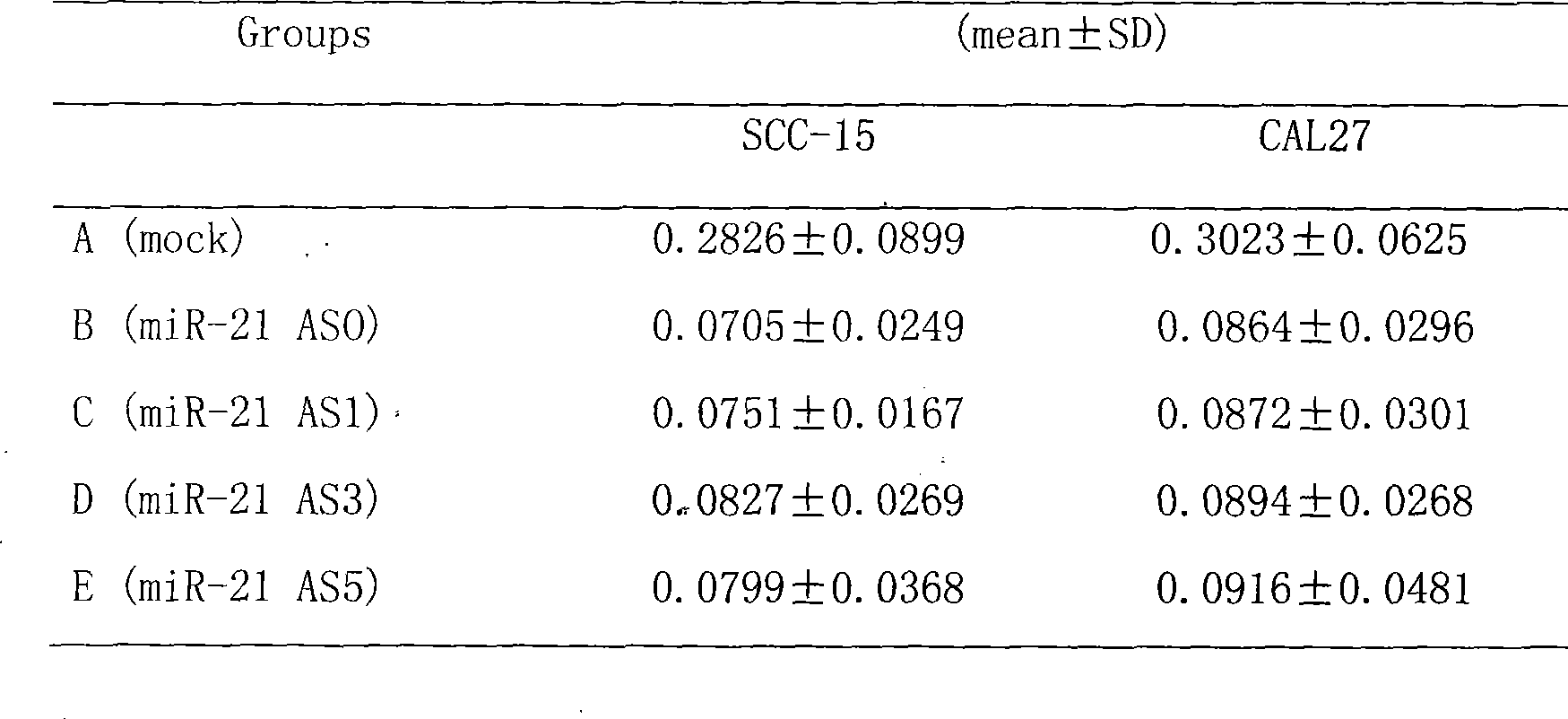MiR-21 antisense digonucleotides and use thereof
An oligonucleotide and mir-21 technology, which is applied in the field of preparation of tumor drugs, can solve the problems of poor curative effect, low survival rate and poor curative effect in patients with distant metastasis, and achieve growth inhibition and Malignant proliferation ability, effect of promoting cell apoptosis
- Summary
- Abstract
- Description
- Claims
- Application Information
AI Technical Summary
Problems solved by technology
Method used
Image
Examples
Embodiment 1
[0016] Example 1 Inhibition of antisense nucleic acid on the expression of miR-21
[0017] The antisense nucleic acid for miR-21 (hereinafter referred to as miR-21 AS) designed and synthesized by the present invention, the number and sequence of the antisense nucleic acid molecule (after full thio modification) are as follows:
[0018] AS0 5’-UCAACAUCAGUCUGAUAAGCUA-3’ (antisense RNA sequence against the full length of miR-21)
[0019] AS1 5’-TCAACATCAGTCTGATAAGCTA-3’ (antisense DNA sequence against the full length of miR-21)
[0020] AS3 5’-AGUCUGAUAAGCUA-3’ (antisense RNA sequence targeting 14 bases at the 5’ end of miR-21)
[0021] AS5 5’-UCAACAUCAGUC-3’ (antisense RNA sequence targeting 12 bases at the 3’ end of miR-21)
[0022] AS6 5’-TCAACATCAGTCTG-3’ (antisense DNA sequence targeting 14 bases at the 3’ end of miR-21)
[0023]AS7 5’-ACAUCAGUCUGAUAAGC-3’ (antisense RNA sequence of 17 bases against the middle region of miR-21)
[0024] The sequence of the control lin4AS0 is: 5’...
Embodiment 2
[0053] Example 2 MTT method to detect cell viability
[0054] The MTT experiment was used to detect the changes in the survival rate of tongue squamous cell carcinoma cells before and after transfection of miR-21 AS0 and TPM-1 siRNA. The results showed that miR-21 AS0, miR-21 AS1, miR-21 AS3, miR-21 AS5 were transfected respectively The survival rate of tongue squamous cell carcinoma cells SCC-15 and CAL27 after miR-21 AS6 and miR-21 AS7 was significantly lower than that before miR-21 AS0 transfection; while there was no significant change in cell survival after transfection with lin4 AS0:
[0055] 1) Collect the transfected tongue squamous cell carcinoma cells and inoculate them in 96-well plates, about 5×10 3 Pcs / well, set at 37℃, 5% CO 2 Incubator culture.
[0056] 2) Calculate 72 hours after transfection, remove the culture medium in each well of the 96-well plate, add 180 μl of fresh DMEM culture medium to each well, then add 20 μl of MTT solution (5 mg / ml), and continue to c...
Embodiment 3
[0061] Example 3 Clone formation experiment to detect cell malignant proliferation ability
[0062] The clone formation experiment was used to detect the changes in the proliferation ability of tongue squamous cell carcinoma cells before and after transfection of miR-21 AS0 and TPM-1 siRNA. The results showed that the clone formation rate of tongue squamous cell carcinoma cells SCC-15 and CAL27 after being transfected with miR-21 AS0, miR-21 AS1, miR-21 AS3, miR-21 AS5, miR-21 AS6, miR-21 AS7, respectively Before miR-21 antisense nucleic acid was transfected, it was significantly reduced, and the difference was significant; while after transfection with lin4 AS0, there was no significant change in the cell clone formation rate:
[0063] 1) After transfection, the tongue squamous cell carcinoma cells are seeded in a flat-bottomed 6-well culture plate, 400 cells / well, shake the culture plate to make the cells evenly distributed, and place at 37℃, 5% CO 2 Incubator culture.
[0064] ...
PUM
 Login to View More
Login to View More Abstract
Description
Claims
Application Information
 Login to View More
Login to View More - R&D
- Intellectual Property
- Life Sciences
- Materials
- Tech Scout
- Unparalleled Data Quality
- Higher Quality Content
- 60% Fewer Hallucinations
Browse by: Latest US Patents, China's latest patents, Technical Efficacy Thesaurus, Application Domain, Technology Topic, Popular Technical Reports.
© 2025 PatSnap. All rights reserved.Legal|Privacy policy|Modern Slavery Act Transparency Statement|Sitemap|About US| Contact US: help@patsnap.com



